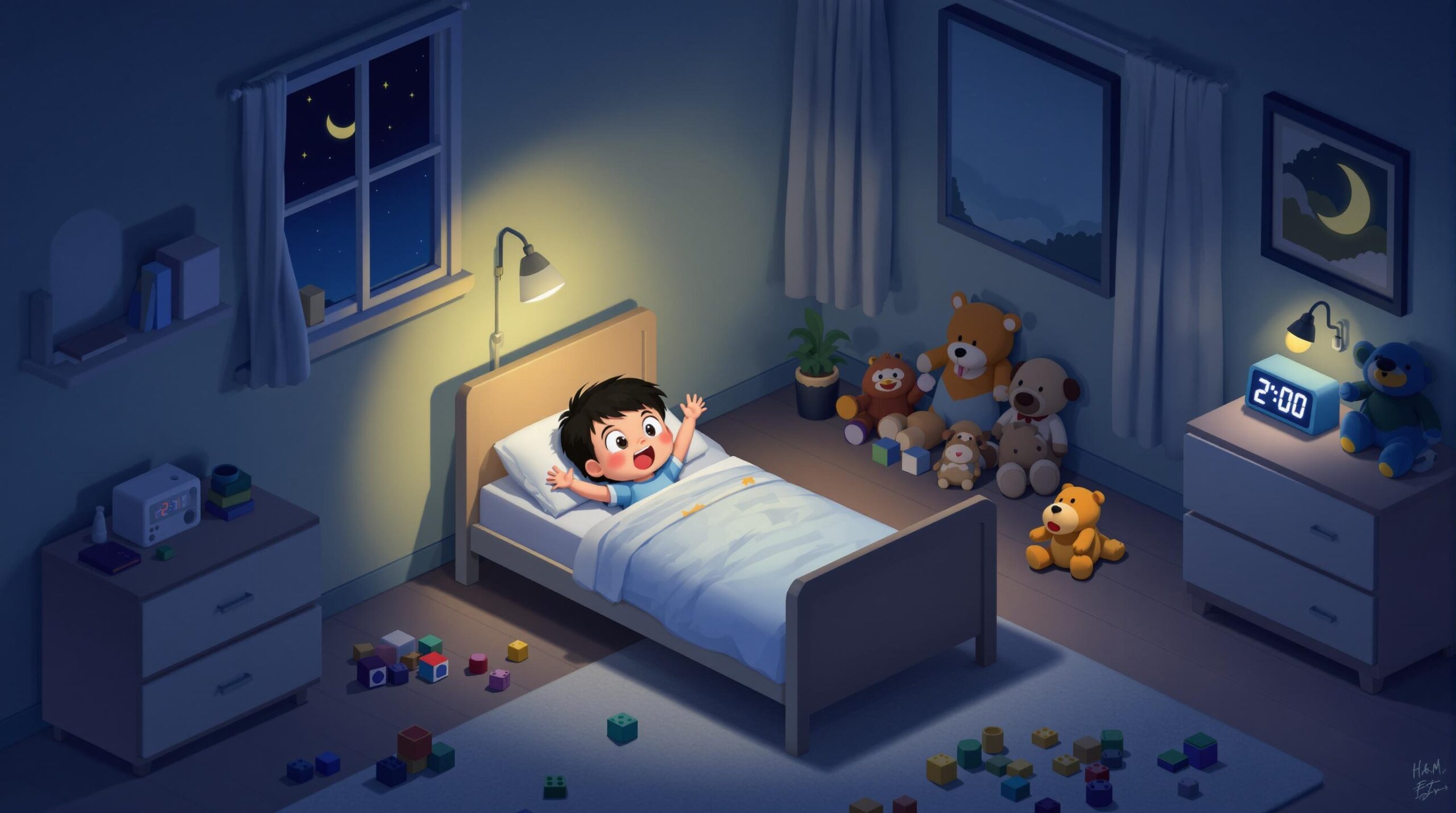Table of Contents
ToggleSleep regression in toddlers can be a frustrating experience for parents. Just when you think you’ve got your little one’s sleep schedule figured out, suddenly everything changes. As a parent, I’ve been there, and I understand the challenges that come with these sleep disruptions. Let’s dive into what causes toddler sleep regression and how we can tackle it effectively.
What is Toddler Sleep Regression?
Toddler sleep regression refers to periods when a child’s sleep patterns change, often resulting in difficulty falling asleep, frequent night wakings, or resistance to bedtime. It’s a common phenomenon that affects many toddlers at various developmental stages. These regressions typically coincide with significant milestones in your child’s growth and development.
Sleep regressions can occur at different ages, but they’re particularly common around 18 months and 2 years. During these times, your once-perfect sleeper might suddenly start fighting bedtime, waking up multiple times during the night, or rising way too early in the morning. It’s important to remember that while these phases can be challenging, they’re typically temporary and a normal part of your child’s development.

Developmental Milestones and Their Impact on Sleep
Understanding the connection between developmental milestones and sleep can help you navigate these regression periods more effectively. Let’s explore some key milestones and how they can affect your toddler’s sleep:
Object Permanence and Separation Anxiety
Around 9 months, babies develop object permanence – the understanding that things continue to exist even when they can’t be seen. This cognitive leap often leads to separation anxiety, which can significantly impact sleep. Your little one might suddenly realize that when you leave the room, you still exist somewhere else, leading to increased night-wakings and resistance to sleep.
To help your child through this phase, try playing peek-a-boo games during the day to reinforce the idea that you always come back. You can also gradually increase the time you spend out of sight during playtime to help build their confidence.
Independent Walking and Exploration
Between 12-18 months, most toddlers master the art of walking independently. This newfound mobility is exciting for your little one, but it can also lead to sleep disruptions. The combination of physical exhaustion and mental stimulation from exploring their environment can make it harder for toddlers to settle down at bedtime.
To address this, ensure your toddler has plenty of opportunities for physical activity during the day. A consistent bedtime routine can also help signal to your child that it’s time to wind down and prepare for sleep.
Language Development
Between 12-24 months, toddlers experience rapid language acquisition. This explosion in vocabulary and communication skills can lead to overstimulation, making it harder for your child to switch off at night. You might find your toddler chattering away in their crib instead of sleeping.
To help manage this, incorporate quiet, calming activities into your bedtime routine. Reading stories or singing lullabies can provide a peaceful way for your child to engage their language skills before sleep.
Common Causes of Toddler Sleep Regression
While developmental milestones play a significant role in sleep regression, there are other factors to consider:
Cognitive Development
Between ages 2-7, children enter what Piaget termed the preoperational stage of cognitive development. This stage involves significant changes in how children think and process information. They begin to engage in symbolic thought, which can keep their minds active even when it’s time to sleep.
To help your child manage this cognitive growth, encourage them to express their thoughts and feelings during the day. This can help prevent an overactive mind at bedtime. You might also try introducing a “worry box” where they can place their concerns before sleep.
Environmental Factors
Changes in routine, travel, or caregivers can disrupt your toddler’s sleep patterns. Toddlers thrive on consistency, and any deviation from their normal schedule can lead to sleep issues.
When facing changes, try to maintain as much of your regular routine as possible. If you’re traveling, bring familiar items from home to create a sense of normalcy in the new environment. This can help your toddler feel more secure and settled for sleep.
Health Issues
Illnesses or physical discomfort can cause frequent wake-ups and disrupt sleep patterns. Common culprits include ear infections, teething pain, or even growth spurts.
If you suspect a health issue is behind your toddler’s sleep regression, consult with your pediatrician. They can provide guidance on managing any discomfort and ensure there are no underlying health concerns.
Strategies to Address Toddler Sleep Regression
Now that we understand what causes sleep regression, let’s explore some effective strategies to address it:
Establishing a Consistent Sleep Routine
A predictable bedtime routine is crucial for maintaining healthy sleep habits. This routine signals to your child that it’s time to wind down and prepare for sleep. Your routine might include a warm bath, storytime, and cuddles.
Consistency is key here. Try to start your routine at the same time each night and follow the same sequence of activities. This predictability provides a sense of security and stability for your toddler, making the transition to sleep easier.
Creating a Sleep-Conducive Environment
Ensure your toddler’s sleep environment is dark, quiet, and comfortable. Use blackout curtains to block out light, which can interfere with your child’s circadian rhythm. A white noise machine can help mask household sounds that might disturb your little one’s sleep.
Consider the temperature of the room as well. A slightly cool room (around 68-72°F) is optimal for sleep. Dress your toddler in comfortable, breathable pajamas to prevent overheating.
Managing Separation Anxiety
If separation anxiety is contributing to your toddler’s sleep regression, gradual separation techniques can help. Start by sitting next to your child’s bed until they fall asleep, then gradually move further away over time.
You might also try using a transitional object, like a special stuffed animal or blanket, to provide comfort when you’re not there. Reassure your child that you’re nearby and will check on them, but it’s important for them to learn to fall asleep independently.
Parental Involvement and Communication
Your role as a parent is crucial in managing sleep regression:
Quality Parent-Child Interaction
Spending quality time with your toddler during the day can help reduce separation anxiety at night. Engage in activities that make your child feel secure and loved. This could be reading together, playing games, or simply talking about their day.
Remember, the goal is to fill your child’s “emotional tank” during the day so they feel more secure at night. This can significantly improve their ability to settle down for sleep.
Open Communication
Address your child’s feelings and concerns about sleep. Even if they can’t fully articulate their worries, showing that you’re listening and understanding can make a big difference.
You might say something like, “I know it’s hard to go to sleep sometimes. What can we do to make bedtime easier for you?” This opens up a dialogue and allows your child to feel heard and involved in the process.
Monitoring Developmental Milestones
Regular monitoring of your child’s developmental milestones is crucial. This practice, known as developmental surveillance, can help you identify potential issues early and ensure your child is progressing as expected.
Keep track of your child’s physical, cognitive, and social-emotional development. If you have concerns about your child’s development or if sleep issues persist despite your best efforts, don’t hesitate to consult with your pediatrician. They can provide personalized advice and rule out any underlying health issues.
Remember, every child is unique, and what works for one might not work for another. Be patient with your toddler and with yourself as you navigate these sleep regressions. With consistency, understanding, and the right strategies, you can help your little one develop healthy sleep habits that will serve them well into childhood and beyond.
If you’re still struggling with getting your toddler to sleep in their own bed or if they’re consistently fighting bedtime, don’t lose hope. These are common challenges that many parents face, and with persistence and the right approach, you can overcome them. Remember, this phase will pass, and restful nights are in your future!
Sources:
Developmental Milestones
Piaget’s Stages of Cognitive Development
Developmental Milestones and Sleep
Parent-Child Interaction and Sleep
Creating a Sleep-Conducive Environment
Establishing a Consistent Sleep Routine
Managing Separation Anxiety
Parental Involvement and Communication
Developmental Surveillance
Health Issues and Sleep













This Post Has One Comment
Pingback: Co-Sleeping with a Toddler: Pros, Cons, and How to Transition – GuideForKids
Comments are closed.